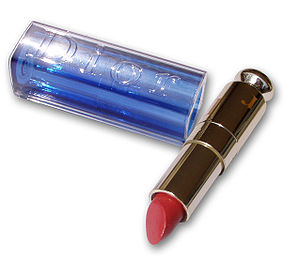
- Image via Wikipedia
Yesterday, Elsevier announced the availability of its first prototypes in its “Article of the Future” initiative. They include links to two prototype articles at Cell.
This seems a follow-up to last year’s “Article 2.0 Contest,” which Elsevier also sponsored. I can’t really tell, because the link from the press release to the “Article of the Future” explanation is dead.
Dead links seem to be a theme here, as you’ll see.
Back in 2008, a few weeks after Elsevier announced the “Article 2.0” contest (which ended December 31, 2008), I wrote a post comparing the effort to putting lipstick on a pig:
I think Elsevier is looking for baubles and tricks, not a fundamentally new approach to publishing and authorship. . . . I think this is akin to putting lipstick (Web 2.0) on a pig (the traditional print article)
The problem with the premise of the contest was that it focused on how an article written for print could be presented online, rather than taking the essence of the communication itself and shifting it from a print environment to a networked, digital environment.
The winners were announced March 31, 2009. You can find a link to all three of the winners’ entries on a page Elsevier has for the contest. Well, except for one of them, the third-place winner, whose link is dead.
The first-place winner of the contest has a pretty interesting approach, but one that would likely fail for a well-used article, for a variety of reasons. The second-place winner’s entry is an Android application, justifying my concerns that the contest would attract only those people facile with software development. The third-place contestant’s application is described as “stochastic,” and “presented is one instance of the interface which the user would be able to customize as they needed.” I mean, isn’t that what we all want? An interface we can reconfigure each time?
No matter, really. It appears that few if any of the ideas offered by the contestants were absorbed into the Cell prototypes Elsevier has on display. And these prototypes reflect the same inherent problem as the contest — article 1.0 in a 2.0 outfit.
So, how are the prototypes? Elaborate, unusable, and disappointing overall. There are a few nice touches (a reference list showing reciprocal context is probably one of the best, and the extended views of some elements are OK). But, ultimately, the information isn’t clearly presented. In fact, it suffers from all the limitations of a print article, but without the benefits of print. The hyperlinking is anemic (either limited pop-ups or Scopus-centric links). The author interview is embedded, so if you go to another tab, it stops playing, a major usability oversight. The figures jump around as you scroll through them — a perfect way to feel like you’re having a seizure — and the element counts don’t always jibe. Social media integration is basic — a standard, off-the-shelf “share” widget and comments that don’t look threaded or robust.
So, Elsevier’s “Article of the Future” looks like an article from the past, with some embedded hyperlinks, some AJAX tabs, two basic social media elements, and not much else.
I’ll close with a few lines from my post about the contest last October:
Article 2.0 as a true experiment would mean that the authoring experience and tools would change, the fundamental data would deepen and become networked, and the presentation would be re-imagined based on the possibilities of Web 2.0. This would fundamentally change the genesis of a research report. The thing that should scare Elsevier and every other traditional publisher is that they are not the ones doing those experiments. These experiments are being created elsewhere.
The results of these Elsevier initiatives — “Article 2.0” and “Article of the Future” — do nothing to change that statement, in my opinion. They are still applying last year’s lipstick to the same old pig.
Discussion
7 Thoughts on "The “Article of the Future” — Just Lipstick Again?"
Kent– Thanks for another interesting post. I just came across an (older) relevant post from John Wilbanks’ Common Knowledge blog (which I found through Michael Neilsen, whose post on disruption in scientific publishing you referred to in your “Fixed Costs of Fixed Ideas” post [http://tinyurl.com/m233yq]).
Wilbanks was discussing on Seed Media’s “State of Innovation” Summit on June 23 and commented on the technical infrastructure for innovation [http://tinyurl.com/mbe89q]:
“There’s no conversation about technical infrastructure for innovation…. There is the assumption that because the web works for culture, it works for science. But the Web is a system built for documents – it’s infrastructure for documents. Science innovation depends on data…. Infrastructure for making the web function on data is woeful – format standards, annotation, and so on are always underfunded and first to cut in crisis.
Infrastructure for data integration, data federation, and so forth should be encoded directly into the open standards of the web and internet. Full stop. And we should talk about this problem more often. Otherwise people look at their iPhones, check for a latte, and assume this level of functionality scales from coffee to the bench. It doesn’t.”
I certainly agree that as publishers we need to experiment more, but perhaps part of the reason the online articles of the future look like the articles of the present is that articles are documents, and as Wilbanks points out, the web prefers documents.
Well, I think Wilbanks is saying something else. Documents as a concept of a finite expression of thought certainly make sense. Who wants an endless data stream of revisions, qualifications, and additions? How that’s realized is the opportunity here. Look at the Cell prototypes. The figures are ganged. Why? Because they were formatted for print. Why have panels 1a-1f when you can have a carousel? Why have supplementary figures, defined by their not being included in the print version? Why only show pictures of data instead of having data applications?
Wilbanks is talking about an infrastructure for documents that’s different from the infrastructure for PRINT documents. He’s talking about an infrastructure for DIGITAL documents. Blogs hint at what is possible. I can put a video, hyperlink, audio file, picture, or even program file into a blog post with ease. Most scientists are writing digital documents, manipulating electronic data, and managing digital images, yet publishers habitually don’t support the transfer of native formats and don’t provide tools for integration with existing data the publisher might own. There are so many opportunities here, but Elsevier and others are focusing on the wrong thing. Anyone experimenting in this area needs to look at the authoring environment. SEED has done this, and could do more.
And, why an article? Why not a document that’s an interactive lesson? An audio file? So much potential . . .
I’ve just been reminded of
http://imageweb.zoo.ox.ac.uk/pub/2008/plospaper/latest/
which is a much worthier claimant of the ‘article of the future’ title. Although keeping the current form of a scientific article, and similar in some ways to Project Prospect’s semantic markup from RSC, it moves beyond both in interesting ways (e.g. citation typing).
![Reblog this post [with Zemanta]](http://img.zemanta.com/reblog_e.png?x-id=a5285757-d7da-48ec-ad0e-0bacb8314c1d)


